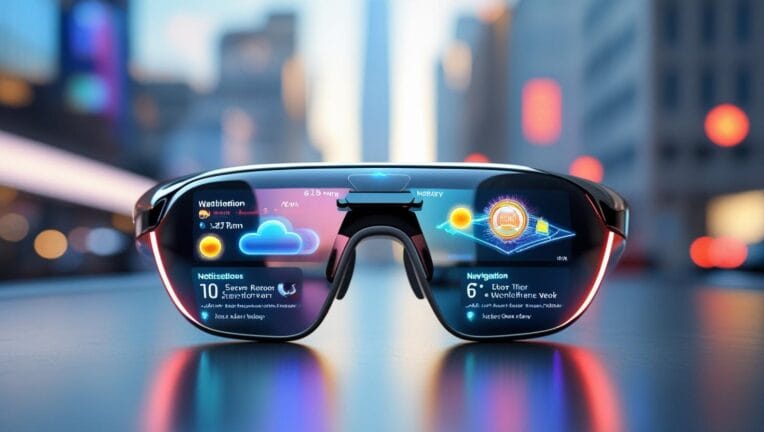
Summary
Meta is preparing to launch its first display-equipped smart glasses, codenamed Hypernova, in September at a starting price of $800. Unlike full AR headsets, Hypernova serves as a bridge device, offering a small display in the right lens for notifications, navigation, and simple apps. The glasses will pair with a neural wristband that allows control through subtle hand movements. By pricing it lower than expected, Meta aims to drive early adoption and position Hypernova as an accessible alternative to expensive headsets like Apple’s $3,499 Vision Pro. This launch marks a major step in Meta’s wearable tech journey, with the potential to bring augmented reality into everyday life.
Table of Contents
Introduction To Meta Hypernova Glasses
Meta is preparing to take a bold step forward in the wearable technology market by introducing its first pair of display-equipped smart glasses, internally known as the Hypernova. According to Bloomberg, the launch is expected in September, and the company is reportedly planning to price the device at around $800—a figure that is significantly lower than early predictions.
This upcoming release is generating buzz not only because of its timing but also because of its pricing strategy, which could make display-equipped glasses more accessible to everyday consumers. Let’s dive into what makes this development noteworthy, how it compares to competitors like Apple, and what it means for the future of augmented reality (AR).
Why the $800 Price Point is a Game-Changer
When the Hypernova was in early development, Meta was believed to be targeting a price well above $1,000, with some estimates reaching as high as $1,400. At that level, the device would have been competing with flagship smartphones and even entry-level laptops, making it a risky purchase for consumers who are still experimenting with wearable displays.
Instead, Meta seems to have revised its approach, bringing the base price closer to $800. While extras like designer frames or prescription lenses will naturally increase the cost, this lower entry point makes the glasses more attractive to a wider audience.
The strategy here is clear: rather than aiming for big margins upfront, Meta is willing to work on thinner profits to encourage early adoption. By removing the intimidation factor of a four-figure price tag, Meta is hoping to spark curiosity among mainstream buyers and slowly normalize the idea of wearing smart glasses daily.

A Bridge Between Smart Glasses and Full AR Headsets
One key distinction is that the Hypernova isn’t being pitched as a full-fledged AR headset. Instead, it serves as a bridge device between basic smart glasses and the advanced AR headsets that tech companies envision for the future.
Features We Know So Far:
Right-lens display: A small screen built into the lens allows wearers to check notifications, alerts, and simple apps without pulling out a phone.
Neural wristband integration: This companion device reads electrical signals from the wrist, enabling users to control the glasses with subtle hand movements instead of physical buttons or touchpads.
Everyday practicality: The device is aimed at people who want quick, seamless access to information like navigation, productivity tools, or messages.
This makes the Hypernova less about immersive virtual worlds and more about convenience and accessibility in everyday life. It could be thought of as a wearable extension of your phone—something light, subtle, and practical rather than bulky and futuristic.
Competition: Meta vs. Apple Vision Pro
Meta’s move also needs to be seen in the broader context of the AR/VR arms race. Apple’s Vision Pro, which launched last year at $3,499, grabbed headlines as a high-end mixed reality headset but has struggled with adoption.
Apple Vision Pro:
Strengths: Cinema-like immersive experience, powerful hardware, Apple ecosystem integration.
Weaknesses: High cost, bulky design, limited content library, modest sales.
Apple is expected to refine the product over time, with a lighter, cheaper model rumored to arrive later this decade. Until then, the Vision Pro is largely an enthusiast and professional product rather than something designed for mass adoption.
Meta Hypernova:
Strengths: Lower price point, practical everyday use, discreet design.
Weaknesses: Limited compared to high-end AR, depends heavily on app ecosystem.
By pricing the Hypernova closer to a premium smartphone than a high-end computer, Meta is deliberately targeting mainstream consumers, betting that people will be more willing to try smart glasses if they’re affordable and useful in daily life.

Building on Meta’s Wearable Journey
This is not Meta’s first foray into wearable tech. The company previously partnered with Ray-Ban to release smart glasses capable of capturing photos, recording videos, and streaming audio. While those were marketed more as lifestyle accessories, the Hypernova represents a deeper leap into true smart functionality.
By adding a built-in display and combining it with an innovative neural wristband, Meta is signaling that it wants its glasses to be practical tools, not just stylish gadgets. This also ties into Meta’s long-term vision of creating a connected ecosystem of devices, from VR headsets like the Quest to AR tools like smart glasses.
Consumer Impact: A First Real Taste of AR in Daily Life
For consumers, the Hypernova could be the first affordable gateway into experiencing augmented reality in daily routines. Instead of being confined to labs or luxury-priced headsets, everyday people could:
Check notifications hands-free while walking or biking.
Navigate city streets with turn-by-turn directions in their glasses.
Handle productivity tasks like reminders, calendars, or quick replies.
Stay connected without constantly reaching for their smartphones.
The practical benefits may prove far more appealing than the flashy promises of “immersive AR worlds” that most people don’t yet feel the need for. If Meta can deliver consistent performance, reliable updates, and strong app integration, the Hypernova could become the first truly useful smart glasses for the average consumer.
Challenges Meta Still Faces
Despite the excitement, several hurdles remain:
Battery Life: Small form factor devices often struggle with short usage time.
Display Limitations: A single-lens display may feel too limited for users expecting more.
Privacy Concerns: Cameras and wearable displays always raise questions about surveillance and security.
Ecosystem Support: Without a strong app library, the glasses could feel like a gimmick.
How Meta addresses these challenges will ultimately determine whether Hypernova becomes a stepping stone to mass AR adoption or simply another niche gadget that fades away.
Meta’s Long-Term Play
The launch of the Hypernova should not be seen in isolation. It is part of Meta’s broader strategy to dominate the AR/VR landscape. By positioning the device as an affordable, accessible entry point, Meta is:
Training consumers to get comfortable with wearable displays.
Gathering valuable user data on how people interact with such devices.
Building momentum toward more advanced AR glasses in the future.
This aligns with CEO Mark Zuckerberg’s long-term vision of creating a metaverse ecosystem where people seamlessly interact across physical and digital environments.
Final Thoughts
Meta’s upcoming Hypernova smart glasses could represent a turning point in wearable technology. By striking a balance between affordability and practicality, Meta is giving consumers a chance to explore display-equipped glasses without breaking the bank.
Unlike Apple’s Vision Pro, which is chasing the ultra-premium market, Meta’s strategy is about building adoption from the ground up. If successful, the Hypernova could do for smart glasses what the iPhone did for smartphones—normalize them as part of everyday life.
Whether these glasses end up being remembered as the first mainstream AR device or just another interesting experiment will depend on how well Meta supports the product after launch. But one thing is certain: the wearable tech race just got a lot more exciting.
Disclaimer: The information in this article is based on details first reported by official sources and publicly available news, including Google News and trends . We have adapted and rewritten the content for clarity, SEO optimization, and reader experience. All trademarks and images belong to their respective owners.
